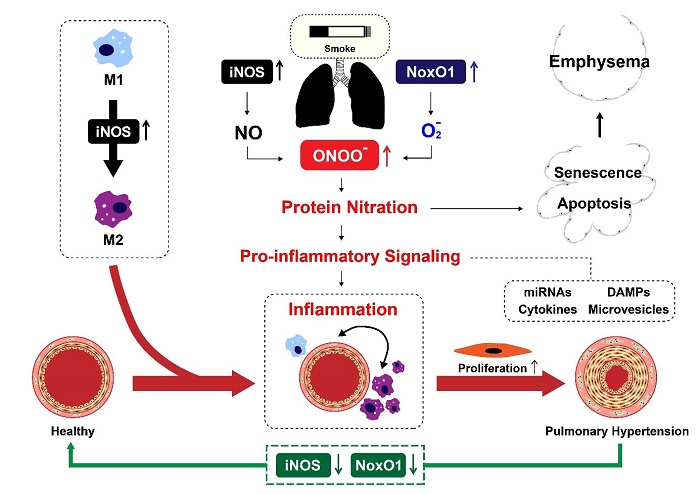A07
iNOS- and NoxO1-based redox signaling in chronic obstructive pulmonary disease (COPD) associated PH – pathomechanisms and therapeutic exploitation
Lung vascular alterations and pulmonary hypertension (PH) have been implicated in the development of emphysema and COPD, and PH correlates with patient survival. Our current work using a cigarette-smoke (CS) mouse model and human biobank material provided evidence that iNOS in macrophages drives CS-induced PH and that this process critically depends on NoxO1-mediated formation of superoxide. We now aim to identify the iNOS- and NoxO1-expressing cell types - and their signaling pathways – that lead to vascular remodeling and reverse remodeling in COPD-PH, and to test the therapeutic potential of the discovered targets for this disease.

Working hypothesis for project A07: Our current work provides evidence for the concept that iNOS-expressing macrophages trigger the pathologic signaling leading to smoke-induced PH, and that this process critically depends on NoxO1-mediated formation of superoxide. To decipher the underlying mechanisms in detail, we will analyze the interactions of iNOS and NoxO1 and their contribution to vascular remodeling and reverse remodeling. Moreover, we aim to delineate pro-inflammatory and pro-proliferative signaling pathways driving COPD-associated PH.
We hypothesize that deep insight into these mechanisms will allow the design of therapeutic concepts to not only stop further progression of COPD-PH, but also to reverse the established disease.
DAMPs=Damage-associated molecular patterns, iNOS=inducible NO synthase, NO=nitric oxide, NoxO1=NADPH oxidase organizer 1, O2-=superoxide, ONOO-=peroxynitrite
